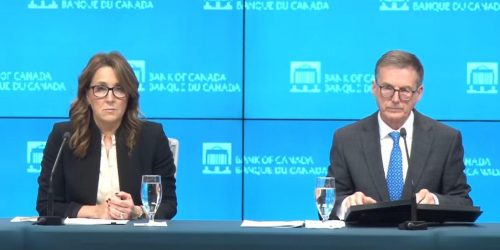Good morning. I am pleased to be here with Senior Deputy Governor Carolyn Rogers to discuss the Bank of Canada’s Financial Stability Report (FSR).
Part of the Bank’s mandate is to preserve and promote the stability of the Canadian financial system. A stable and resilient financial system means people can access credit and manage their assets safely and predictably in good times and in bad. It also reduces the need for authorities to intervene in periods of financial stress. In short, a stable financial system is critical to Canada’s economic well-being.
Every year the Bank publishes this Report to offer an assessment of the stability of Canada’s financial system and highlight risks that could threaten that stability. To make the purpose of the Report clear, we’ve changed its name, from the Financial System Review to the Financial Stability Report.
The Canadian financial system is highly interconnected. Stress in one sector can spread to others. So, the emphasis in the FSR is on risks that could ultimately affect the broader financial system and threaten its stability.
The Report focuses in particular on risks that evolve with developments in the economy. We look at risks that could lead to system-wide stress, in four key sectors: households, businesses, banks and non-bank financial institutions—such as pension funds, insurance companies and fund managers.
There are also important risks that are more operational or structural in nature, such as cyber attacks and risks related to climate change. We typically will discuss those on the Bank’s Financial System Hub. But when major developments arise, they may appear in the FSR as well.
So, what are the key messages from today’s FSR?
The first message is that Canada’s financial system remains resilient.
Over the past year, households, businesses, banks and other financial institutions have taken proactive steps to adjust to higher interest rates and to weather economic shocks.
The second message is that this adjustment still has some way to go and continues to present risks to financial stability.
I’ll offer some context around this assessment and then the Senior Deputy Governor will touch on the risks in different sectors.
Over the past year, the risk of recession has diminished in Canada and globally. Inflation in most economies has come down, and inflation targets are in sight. However, there could be volatility in markets as expectations shift about when and by how much central banks will lower their policy rates. And there continue to be important geopolitical and economic risks on the horizon.
Against this backdrop, households and businesses continue to adjust to past interest rate increases. Some indicators of financial stress have risen. At the same time, the valuations of some financial assets appear to have become stretched. This increases the risk of a sharp correction that could generate system-wide stress. The recent rise in the use of leverage in the non-bank financial sector could amplify the effects of such a correction.
What’s most important is that to properly manage risks, financial system participants need to remain proactive. And financial authorities need to remain vigilant.
Let me now pass things over to Carolyn.
Thank you, Governor.
Let me touch on each of the sectors we cover in the FSR.
I’ll start with households. So far, most households have proven resilient in the face of higher interest rates and inflation. Overall, we’ve seen households adjusting to higher debt-servicing costs.
This does not mean the adjustment has been easy. Clearly, there are individuals and families who are feeling very stretched.
What we’re evaluating in the FSR are the indicators of overall stress in the system.
Some of the indicators of household financial stress that fell during the pandemic are back to or above normal levels. Survey data suggest renters are experiencing the biggest increase in financial stress. After hitting historical lows during the pandemic, the share of households without a mortgage that are behind on credit card and auto loan payments has come back up to—or surpassed—typical levels. And over the past year, the share of borrowers without a mortgage who carry a credit card balance of at least 80% of their credit limit has continued to climb.
Among mortgage holders, indicators of financial stress have remained relatively low even as many have been coping with higher mortgage payments.
Since the Bank began raising its policy rate in March 2022, payments have increased for roughly half of all outstanding mortgages. Over the next two and a half years, most of the remaining mortgages will renew, and these borrowers are likely to face relatively larger payment increases. At the same time, many mortgage holders have also seen their wages go up. Some have proactively adjusted their spending to help offset higher debt payments. Many also report higher levels of savings available to offset increased payments.
Overall, the evidence suggests that households have the flexibility to continue servicing their debt at higher rates. We will be watching the data closely for signs of increased financial strain among households, both mortgage holders and non-mortgage holders. We’ll also be watching how the labour market evolves, since the biggest factor that determines whether someone can service their debt is if they have a stable income.
Higher interest rates are also affecting businesses. Higher rates are slowing demand for the goods and services that businesses sell, while also increasing their financing costs. So far, the financial health of large businesses appears solid. But smaller businesses are showing more signs of financial stress. Insolvency filings by smaller firms have recently jumped after several years of below-average filings. There is some indication that this recent increase could be a catch-up or normalization, and the timing could be driven in part by the expiry of government support programs put in place during the pandemic.
Turning to Canadian banks, overall, credit performance remains strong. Banks are proactively contacting customers who are facing payment increases at renewal and working with them on a payment plan. They have also been putting more money aside to cover future loan losses, and they continue to maintain healthy capital and liquidity buffers. This means that even if financial conditions and credit performance deteriorate, banks are positioned to absorb losses and continue to provide credit.
In the non-bank financial sector, more frequent volatility in financial markets in recent years has led to an increased focus on liquidity risks. At the same time, some firms are increasingly using leverage, or borrowed money, to fund trading activities. This makes them more vulnerable in the event of large market swings.
Let me close by repeating an important point the Governor made at the beginning: the connections in the financial system mean that if risks materialize in one sector, they can spread quickly. This puts a premium on preparedness. The proactive steps taken by financial system participants have been positive. And they need to continue. A stable and resilient financial system benefits all Canadians.
The Governor and I will now be happy to take your questions.

Financial Stability Report—2024
Canada’s financial system remains resilient. Over the past year, households, businesses, banks and non-bank financial institutions have continued to proactively adjust to higher interest rates. But this adjustment is not yet over and continues to present risks to financial stability. Key risks include those related to debt serviceability and asset valuations.


Press Conference: Financial Stability Report—2024
Release of the Financial Stability Report — Press conference by Governor Tiff Macklem and Carolyn Rogers, Senior Deputy Governor (11:00 (ET) approx.).